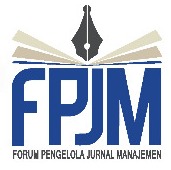The Impact of Hedging on Firm Value of Public Non-Bank State-Owned Enterprises
Abstract
This research aimed to find the impact of hedging on firm value. This research focused on 14 public non-bank state-owned enterprises listed in Indonesia Stock Exchange. The data used were quarterly data from 2011 to 2015, and panel data analysis. The basic model of research used referred to the research of Júnior & Laham (2008) as well as the development of models conducted by Allayanis & Weston (2001) to correct endogenous factors. The results showed that only five of the fourteen state-owned corporations that used a hedging instrument. The research findings showed that the firms which did hedging had a higher value than a firm that did not do it. A more detailed investigation found that the adoption of hedging strategies could increase the firm value, and the dislocation of the hedging strategy had a negative effect on the firm value, compared to firms that kept implementing hedging strategy. The magnitude of hedging measured using the Total Notional Value of Derivative to Total Assets (TNVD) also had a positive impact on the firm value. This finding also supported Bank Indonesia Regulation Number 15/8/PBI/2013 which was effective in reducing exchange rate risk for state-owned enterprises which in turn increased the firm value.
JEL Classification : G 2 1, G 28 , G3 2, G38
Keywords
Full Text:
PDFReferences
Allayanis, G., & Weston, J. P. (2001). The use of foreign currency derivatives and firm market value. The Review of Financial Studies Spring, 14(1), 243-276.
Ameer, R. (2010). Determinants of corporate hedging practices in Malaysia. International Business Research, 3(2), 120-130.
Ammon, N. (1998). Why hedge? A critical review of theory and empirical evidence. International Finance and Financial Management, 1-44.
Antwi, S., Mills, E., & Zhao, X. (2012). Capital structure and firm value: Empirical evidence from Ghana. International Journal of Business and Social Science, 3(22), 103-111.
Bodnar, G.M, Tang, C., & Weintrop, J. (1999). Both side of corporate diversification: The value impact of geographic and industrial diversification. Working Paper. John Hopkin University.
Campello, M., Lin, C., Ma, Y., & Zou, H. (2011). The real and financial implications of corporate hedging. Journal of Finance, 66(5), 1615–1647.
Carter, D. A., Rogers, D. A., & Simkins, B. J. (2006). Hedging and value in the U.S. Airline Industry. Journal of Applied Corporate Finance, 18(4), 21-33.
Chalmers, K. (2001). The progression from voluntary to mandatory derivative instrument disclosures-¬look who’s talking. Australian Accounting Review, 11(1), 34¬-45.
Chalmers, K., & Godfrey, J. (2000). Practice versus perception in the disclosure and recognition of derivatives. Australian Accounting Review, 10(21), 40-50.
Chen, J., & Chen, Y. (2011). The influence of profitability on firm value with capital structure as the mediator and firm size and industry as moderators. Investment Management and Financial Innovations, 8(3), 121-129.
Djohanputro, B. (2008). Manajemen Risiko Korporat. Jakarta: Penerbit PPM.
Hagelin, N., & Pramborg, B. (2002). Hedging foreign exchange exposure: Risk reduction from transaction and translation hedging. Journal of International Financial Management and Accounting, 15(1), 1-20.
He, J., Ng, L. K., & Wu, X. (1998). Foreign exchange exposure, risk, and the Japanese Stock Market. The Journal of Finance, 53(2), 733-753.
Hendrawan, R. (2017). Forward, forward option and no hedging which one is the best for managing currency risk? Jurnal Keuangan dan Perbankan, 21(3), 356–365.
Hohensee, M., & Lee, K. (2006). A survey on hedging markets in Asia: A description of Asian derivatives markets from a practical perspective. Bank of International Settlement No.30, 261-281.
Hu, C., & Wang, P. (2005). The Determinants of foreign currency hedging–evidence from Hong Kong Non-Financial Firms. Asia-Pacific Financial Markets, 12(1), 91-107.
Jin, Y., Jorion, P. (2006). Firm value and hedging: Evidence from U.S. oil and gas producers. Journal of Finance, 61(2), 893–919.
Júnior, R., & Laham, J. (2008). The impact of hedging on firm value: Evidence from Brazil. Journal of International Finance and Economics, 8, 76-91.
Kapitsinas, S. (2008). Derivatives Usage in Risk Management. Athens, Greece: Munich Personal RePEc Archive.
Lang, L. H., & Stulz, R. M. (1994). Tobin's Q, corporate diversification, and firm performance. Journal of Political Economy, 102(6), 1248-1280.
Nguyen, H., & Faff, R. (2003). Can the use of foreign currency derivatives explain variations in foreign exchange exposure? Evidence from Australia Companies. Journal of Multinational Financial Management, 13(3), 193-215.
Pennings, J. M. E, & Meulenberg, M. T. G. (1997). Hedging Risk in Agricultural Futures Markets. Agricultural Marketing and Consumer Behavior in A Changing World, 125-140.
Smith, C. W., & Stulz, R. M. (1985). The determinants of firms' hedging policies. The Journal of Financial and Quantitative Analysis, 20(4), 391-405.
Yang, C. C., Lee, C. F., Gu, Y. X., & Lee, Y. W. (2010). Co-determination of capital structure and stock returns--A LISREL approach: An empirical test of Taiwan stock markets. The Quarterly Review of Economics and Finance, 50(2), 222-233.
DOI: https://doi.org/10.26905/jkdp.v22i2.1967
Refbacks
- There are currently no refbacks.
Jurnal Keuangan dan Perbankan (Journal of Finance and Banking)
Diploma Program of Banking and Finance, Faculty of Economics and Business, University of Merdeka Malang
Published by University of Merdeka Malang
Mailing Address:
2nd floor Finance and Banking Building, Jl. Terusan Raya Dieng No. 57 Malang, East Java, Indonesia
Phone: +62 813-3180-1534
Email: jkp@unmer.ac.id
 This work is licensed under a Creative
This work is licensed under a Creative
Commons Attribution-ShareAlike 4.0




